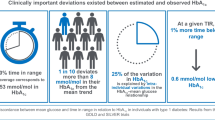Summary
In patients with maturity onset diabetes serum chlorpropamide concentrations (s-CPA) and fasting blood glucose (FBG) were measured before and after self recording of drug intake in order to evaluate the role of compliance with the therapeutic regimen in variation in s-CPA and clinical outcome. Nine out of 57 patients (16%) had to be excluded because they did not comply with the clinical routines and the test procedure. of the remaining 48 patients, only two recorded small deviations from the prescribed dosage, and nine (19%) noted variations in medication time of more than ±2 h. By contrast, irregular drug intake was indicated in 29 of the 48 patients (60%) based on statistical evaluation of changes in s-CPA. Clinical control (FBG) was influenced significantly in only half of these 29 patients. Improved adherence to the dietary regimen was observed in 12 of the 48 patients (25%). Patient medication behaviour seems to be an important determinant of variation in s-CPA, and is as important as adherence to the dietary regimen in clinical control of “drug requiring” patients with maturity onset diabetes.
Similar content being viewed by others
References
Alván G (1978) Individual differences in the disposition of drugs metabolised in the body. Clin Pharmacokinet 3: 155–175
Sjöqvist F, Borgå O, Orme ML'E (1976) Fundamentals of clinical pharmacology. In: Avery GS (Ed) Drug treatment. Principles and practice of clinical pharmacology and therapeutics. Adis Press, Churchill Livingstone, Sydney London, pp 1–42
Sackett DL (1976) The magnitude of compliance and noncompliance: In: Sackett DL, Haynes RB (eds) Compliance with therapeutic regimens. Baltimore: John Hopkins University Press, Baltimore, pp 9–25
Bechtel P, Richard A, Sandoz M, Grandmottet P, Narboni G, Schwager JC (1976) Usefulness of determination of plasma concentrations of glicazide in monitoring the treatment of diabetics. In: Siest G, Young N, Young DS (eds) Drug interference and drug measurement in clinical chemistry. Karger, Basel, pp 153–158
Melander A, Sartor G, Wåhlin E, Scherstén B, Bitzén PO (1978) Serum tolbutamide and chlorpropamide concentrations in patients with diabetes mellitus. Br. Med. J. 1: 142–144
Bergman U, Christenson I, Jansson B, Wiholm B-E, Östman J (1980) Wide variation in serum chlorpropamide concentration in outpatients. Eur J Clin Pharmacol 18: 165–169
Bergman U (1978) Utilization of antidiabetic drugs in the island of Gotland, Swedem — agreement between wholesales figures and prescription data. Eur J Clin Pharmacol 14: 213–220
Bergman U (1978) Drug utilization — geographical differences and clinical implications — antidiabetic drugs. In: Duchéne-Marullaz P (ed) Advances in pharmacology and therapeutics. Vol. 6. Pergamon Press, Oxford New York, pp 123–132
Prescott LF, Redman DR (1972) Gas-liquid chromatographic estimation of tolbutamide and chlorpropamide in plasma. J Pharm Pharmacol 24: 713–716
Watkins JD, Williams TF, Martin DA, Hogan MD, Anderson E (1967) A study of diabetic patients at home. Am J Public Health 57: 452–459
Davis MS (1966) Variations in patients' compliance with Doctors' Orders: Analysis of Congruence Between Survey Responses and Results of Empirical Investigations. J Med Educ 41: 1037–1048
Charney E, Bynum R, Eldredge D, Frank D, MacWhinney, JB, McNabb N, Scheiner A, Sumpter E, Iker H (1967) How well do patients take oral penicillin? J Pediat 40: 188–195
Caron HS, Roth HP (1968) Patients' Cooperation with a Medical Regimen. J Am Med Assoc 203: 922–926
Roth HP, Caron HS, Hsi BP (1971) Estimating a patient's cooperation with his regimen. Am J Med Sci 262: 269–273
Roth HP, Caron HS (1978) Accuracy of doctors' estimates and patients' statements on adherence to a drug regimen. Clin Pharmacol Ther 23: 361–370
Norell SE (1980) Accuracy of patient interviews and estimates by clinical staff in determining medication compliance. Soc Sci Med in press
Feinstein AR, Wood HF, Epstein JA, Taranta A, Simson R, Tursky E (1959) A controlled study of three methods of prophylaxis against streptococcal infection in a population of rheumatic children. N Engl J Med 260: 697–702
Bergman AB, Werner RJ (1963) Failure of children to receive penicillin by mouth. N Engl J Med 268: 1334–1338
Park LC, Lipman RS (1964) A comparison of patient dosage deviation reports with pill counts. Psychopharmacologia 6: 299–302
Rickels K, Briscoe E (1970) Assessment of dosage deviation in outpatient drug research. J Clin Pharmacol 10: 153–160
Hecht AB (1974) Improving medication compliance by teaching outpatients. Nurs Forum 13: 113–129
Chaves AD (1960) Results of the PAS urine test (Phenistix) study done in May and June, 1959. Am Rev Respir Dis 81: 111–112
Preston DF, Miller FL (1964) The tuberculosis outpatient's defection from therapy. Am J Med Sci 247: 21–25
Wilcox DRC, Gillan R, Hane EH (1965) Do psychiatric outpatients take their drugs? Br Med J 2: 790–792
Gordis L, Markowitz M, Lilienfeld AM (1969) The Inaccuracy in using interviews to estimate patient reliability in taking medications at home. Med Care 7: 49–54
Eshelman FN, Fitzloff J (1976) Effect of packaging on patient compliance with an antihypertensive medication. Curr Ther Res 20: 215–219
Sackett DL, Haynes RB, Gibson ES, Hackett BC, Taylor DW, Roberts RS, Johnson AL (1975) Randomised clinical trial of strategies for improving medication compliance in primary hypertension. Lancet 1: 1205–1207
Taylor JA (1972) Pharmacokinetics and biotransformation of chlorpropamide in man. Clin Pharmacol Ther 13: 710–718
Gundert-Remy U, Remy C, Weber E (1976) Serum digoxin levels in patients of a general practice in Germany. Eur J Clin Pharmacol 10: 97–100
Johnston GD, Kelly JG, McDevitt DG (1978) Do patients take digoxin? Br Heart J 40: 1–7
Johnston GD, McDevitt DG (1978) Digoxin compliance in patients from general practice. Br J Clin Pharmacol 6: 339–343
Author information
Authors and Affiliations
Rights and permissions
About this article
Cite this article
Wiholm, B.E. Irregular drug intake and serum chlorpropamide concentrations. Eur J Clin Pharmacol 18, 159–163 (1980). https://doi.org/10.1007/BF00561584
Received:
Accepted:
Issue Date:
DOI: https://doi.org/10.1007/BF00561584




